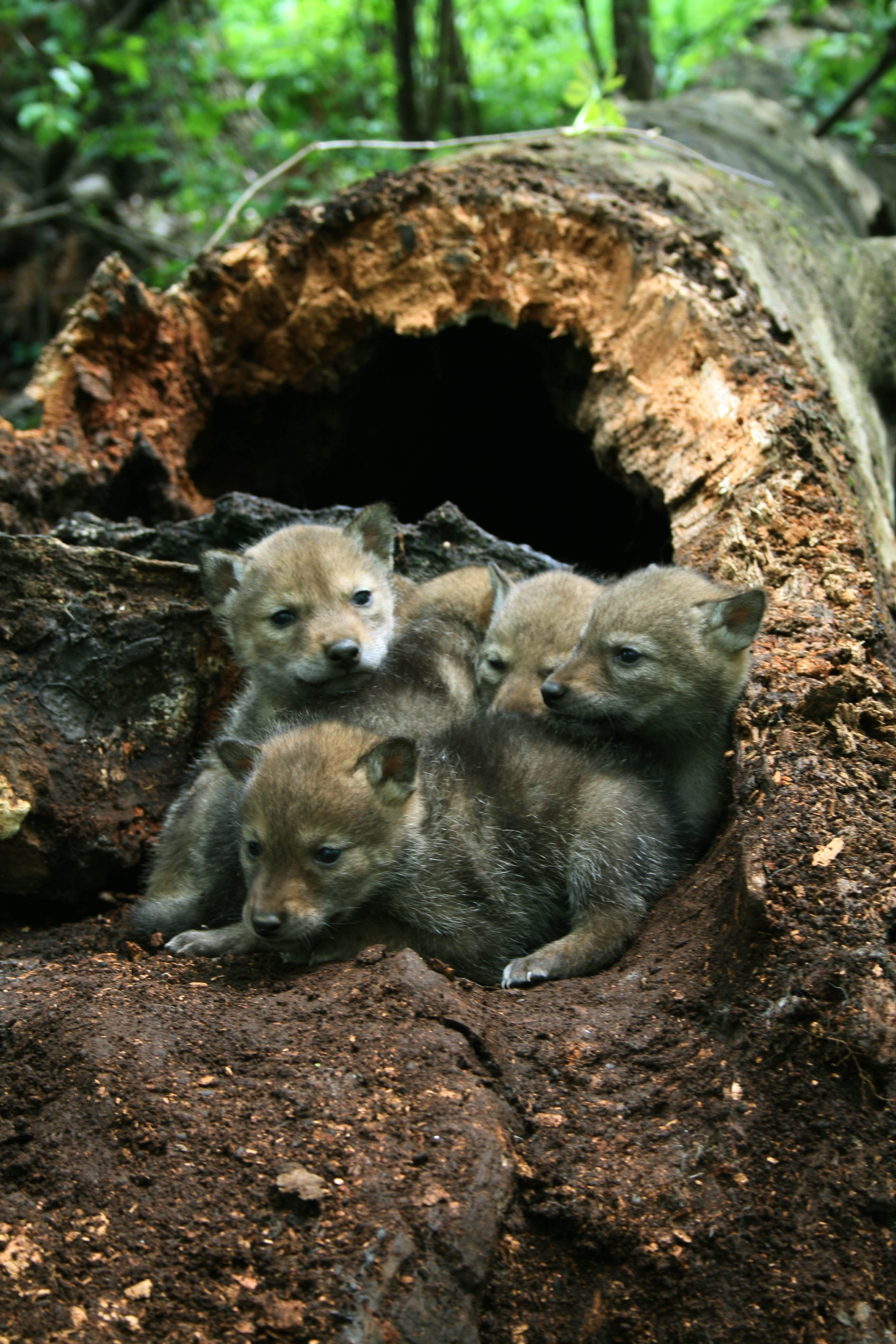
Description
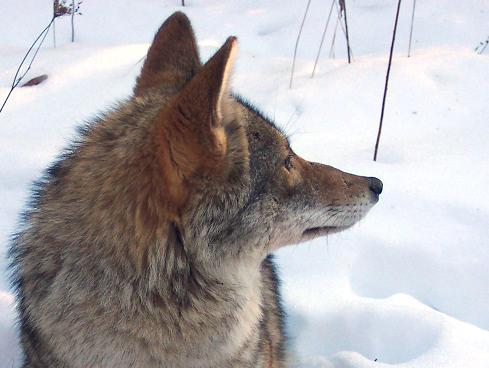
Typical profile: long snout and large upright ears
The coyote is a medium-sized member of the dog family that includes wolves and foxes. With pointed ears, a slender muzzle, and a drooping bushy tail, the coyote often resembles a German shepherd or collie. Coyotes are usually a grayish brown with reddish tinges behind the ears and around the face but coloration can vary from a silver-gray to black. The tail usually has a black tip. Eyes are yellow, rather than brown like many domestic dogs. Most adults weigh between 25-35 pounds, with a few larger individuals weighing up to 42 pounds.
Habitat
Although coyotes can use any habitat, they typically prefer open areas, such as the prairie and desert. Current research is dedicated to understanding coyote habitat selection within urban areas, in order to understand if coyotes benefit from human-associated developments (i.e. are synanthropic species) or if they are merely occurring in human-populated areas due to increased sprawl and fragmentation.
In urban areas, coyotes prefer wooded patches and shrubbery, which provides shelter to hide from people. Our research has found that within the urban matrix, coyotes will avoid residential, commercial, and industrial areas but will use any remaining habitat fragments, such as those found in parks and golf courses.
Diet
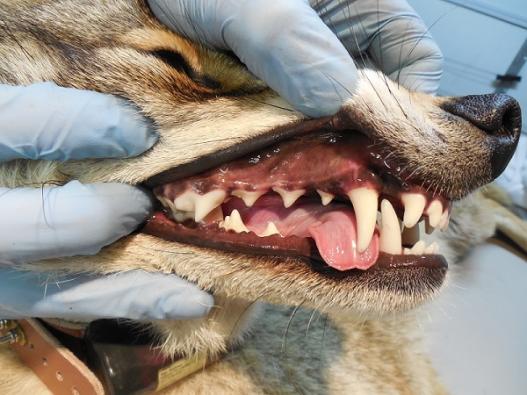
Coyotes can capture large prey but will also feast on berries and plants
Some people believe that urban coyotes primarily eat garbage and pets. Although coyotes are predators, they are also opportunistic feeders and shift their diets to take advantage of the most available prey. Coyotes are generally scavengers and predators of small prey but can shift to large prey occasionally. Researcher Paul Morey analyzed scat (fecal matter) contents at different locations within our study area. After investigating 1,429 scats, he found that diet items varied across space and time, which reflects the flexible food habits of coyotes.
The most common food items were small rodents (42%), fruit (23%), deer (22%), and rabbit (18%). (Scats often have more than one diet item; therefore, frequencies do not necessarily add up to 100%). Apparently, the majority of coyotes in our study area do not, in fact, rely on pets or garbage for their diets.
Another way coyote diets can be determined is by performing necropsies (like autopsies in people) of deceased coyotes. These are either study animals that died or road-killed animals that are found; even though they are dead, these coyotes still provide a wealth of knowledge about their lives. For diet analysis, the stomach and intestinal tract are investigated to classify and quantify contents. The diet results found by Morey is often mimicked by what is found through necropsy. Rodents are nearly always present in the diet, with a mixture of other items depending on the season. Stomach contents may provide the most exact picture of what a coyote is eating because it is not yet digested and still identifiable. While this only shows the most recent meal of any animal, when compared to many other mortalities, results are consistent.
Visit the new research page for information on a novel scientific procedure we are now using to further investigate diets.
Breeding
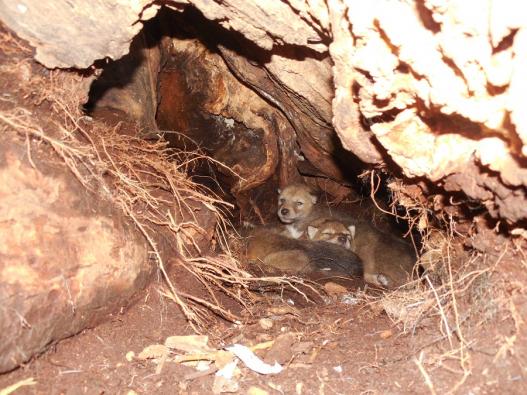
Coyote den example
Mating and Gestation
Coyotes typically mate in February, however, only the alpha pair in a pack will mate and subordinates will usually help raise the young. Coyotes appear to be strongly monogamous and so far, bonds between alpha pairs have only been broken upon the death of one of the pair. Therefore, a number of pairs have maintained bonds for multiple years (read the story about coyotes 1 and 115). In April, after a 62 to 65-day gestation period, the female will begin looking for existing dens or dig one herself.
The Den
Pup season is the only time coyotes will voluntarily use a den; otherwise, coyotes usually sleep above ground in the open or in cover. Dens may consist of a hollowed-out tree stump, rock outcrop, or existing burrow made by raccoons, skunks or other medium-sized carnivores. Coyotes will also build dens from scratch by digging a hole. They usually prefer some protective cover at the den, such as bushes or trees, and some type of slope for drainage. It is not uncommon for mothers to move their young from den to den to keep them protected or to re-use the same den in multiple years. Some coyotes select secluded areas for their dens, whereas others in more urbanized areas have less selection and may use dens near buildings or roads or even in parking lots.
The Litter
Litter sizes often range from four to seven pups, though some litters can be bigger and some smaller. The largest litter found during this study held 11 pups in one den. Coyotes have the ability to adjust their litter sizes based on food abundance and population density. While it is difficult to get reliable estimates of litter sizes in urban areas, best estimates suggest that litter sizes are larger than average, indicating an abundant food supply. Pups stay in the den for about six weeks and then begin traveling short distances with adults. By the end of summer, pups are spending some time away from parents and attempting to hunt on their own or with siblings.
Life Expectancy
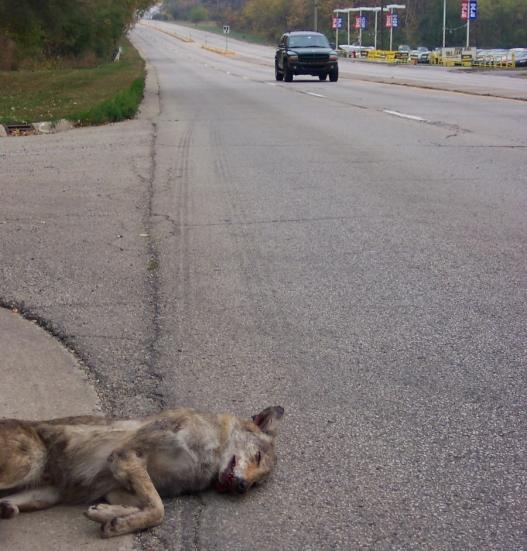
The most common cause of death for urban coyotes
In captivity, coyotes can live 13 to 15 years but in the wild, most die before they reach three years of age. The oldest confirmed wild coyote so far in this research was an eleven-year-old alpha female, Coyote 1. In this study, we found that coyotes in the Chicago area generally have a 60% chance of surviving one year. Many pups die from a variety of causes during their first few ventures away from their homes. Survival is fairly consistent among seasons, even during the winter. Survival rates of adult coyotes in the Chicago metropolitan area are similar to estimates for coyotes living in rural Illinois. However, the survival rates of juvenile coyotes in Cook County are approximately five times higher than the 13% survival rate reported for rural juvenile coyotes. Rural Illinois is dominated by row-crop agriculture and hunting of coyotes occurs year-round without any regulatory constraints, such as bag limits. Given this intensive hunting and trapping pressure found in rural Illinois, coyote vulnerability is magnified during parts of the year in which substantial cover/shelter (e.g. agricultural crops) is lost due to crop harvesting. Large metropolitan areas, on the other hand, provide more year-round protection since there is no seasonal loss of habitat via crop harvesting and a lack of intensive hunting pressure.
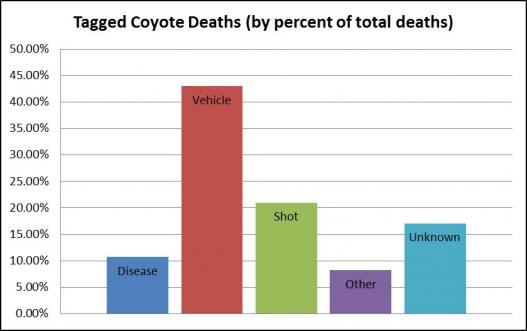
Breakdown of 281 radio-collared coyote deaths (years 2000 to 2014)
By far, the most common cause of death for urban coyotes has been collisions with vehicles (40 to 70% of deaths each year). Given the large areas traversed by coyotes and the number of roads regularly crossed during their activities, this is not surprising. Some of the roads crossed by coyotes in this study have average traffic volumes of more than 100,000 vehicles every 24 hours. Other causes of death have included shootings and malnutrition; disease is primarily due to mange; and sometimes the death is just too complicated to determine a reason. Few coyotes make it through their full potential life spans, unlike Coyote 1 who died of natural causes despite existing in a heavily urbanized area.
Coyote Social Life
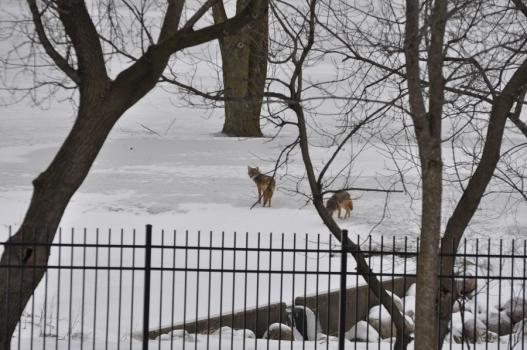
Coyotes can live in packs or as solitary animals
Coyotes typically have a highly organized social system, even in urban areas. This consists of packs, or groups, of coyotes that defend territories from other coyotes. In Cook County, coyotes have been identified as living in packs as well as traveling alone (solitary coyotes). Packs are usually composed of an alpha male and female pair, and a few other coyotes. Genetic analysis of coyotes has revealed that nearly all pack mates are close relatives, except for the alpha pair.
Defending Territories
Observations (during tracking, helicopter flights, and trapping) have revealed that the coyotes in this study maintain their territories as groups. Group size in protected habitats is typically five to six adults in addition to pups born that year. Territories have very little overlap, so the coyotes defend these areas from other groups. In rural areas, especially where hunting and trapping are common, the group may only consist of the alpha pair and the pups.
Hunting & Travel
Although coyotes live in family groups, they usually travel and hunt alone or in loose pairs. In this way they are different from wolves, which sometimes leads to the impression that coyotes do not form packs since they are usually seen alone.
Solitary Coyotes
In addition to resident packs, the urban population also consists of solitary coyotes that have left packs and are looking to join groups or create their own territories. Between one-third and one-half of the coyotes studied each year are solitary animals. They can be either males or females and are usually young coyotes (six months to two years old) but can also be older individuals who have left packs. Solitary coyotes travel over large areas, up to 60 square miles covering many different municipalities; some coyotes may even disperse to different states. These animals must travel between and through, resident coyote territories. Read the story about coyote 571 for an example of this coyote social class.
If a coyote is seen running across a field, it is impossible to know if it is a solitary coyote or a member of a pack from that sighting.
